
Growing up in Kathmandu was magical. At the time, literally a small quaint Kingdom. A home with a small cow shed and an orchard in the backyard. A larger than life tree towering over an old temple, stretching it’s long arms over the entire neighbourhood. At dawn the sounds of brobdingnagian temple bells, struck loud enough to invoke the gods from their sleep. All that against the backdrop of a cacophony of the zillion birds that lived on this tree. Giant wheel chariots, living goddesses and royal processions. The infamous Titaura (local sweet and spicy candy) for which would endeavour any Everest. Demons and Yeti’s were still real and come autumn, the breeze would fill the skies with kites. Not a day went by without adventure.
Photo by @sumitdayal
#nepalphotoproject?#
Tag: disasters
Bangladesh Needs Strong Unions, Not Outside Pressure
By Fazle Hasan Abed in New York Times
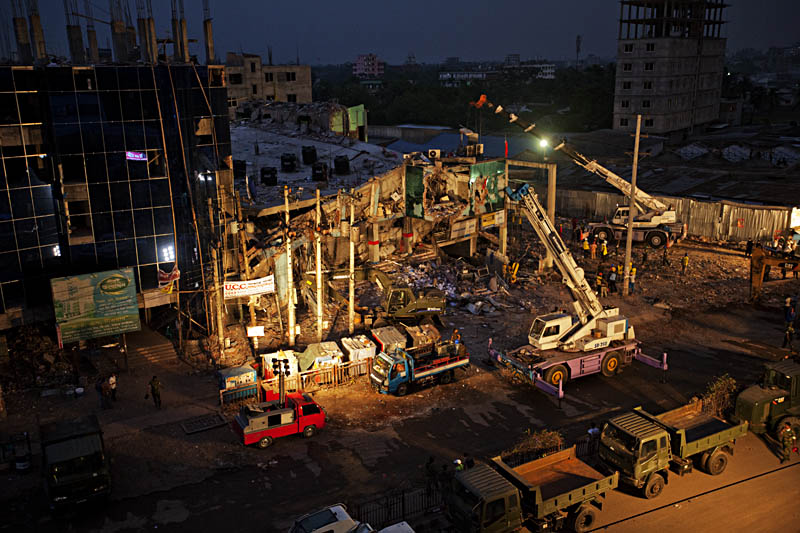
BANGLADESH, my country, is again in tears. Last week in Savar, a suburb of Dhaka, the capital, a poorly constructed building that housed garment factories and other businesses collapsed. More than 300 have been confirmed dead, and the final death toll could well exceed 700. Continue reading “Bangladesh Needs Strong Unions, Not Outside Pressure”
While Awami League Fiddles
While the nation mourned for the hundreds killed in the launch disaster. Awami League party members were seen in truck convoys celebrating to band music.
Dozens Dead After Ferry Capsizes in Bangladesh
By NIKHILA GILL and SRUTHI GOTTIPATI
New York Times
Published: March 13, 2012
Photos by Abir Abdullah/EPA
NEW DELHI ? Rescuers were searching for survivors on Tuesday after a ferry carrying as many as 200 passengers capsized in Bangladesh, killing at least 24 people with many more feared dead.

Continue reading “While Awami League Fiddles”
Death Traps: Tales of a Mega Community
Subscribe to ShahidulNews
By Abir Abdullah
Vice Principal Pathshala
(Abir was a student of the first batch of students of Pathshala)
A fire broke out on 03 june 2010 night at about 9pm after the electrical transformer at Nawab Katra in Nimtali in Dhaka City burst into flames that raced through several apartment complexes, feeding on flammable chemicals and plastic goods in a string of small shops lining the street beneath, fire officials said. Dearh toll rose to 119 while many are struggling in the hospitals for life.
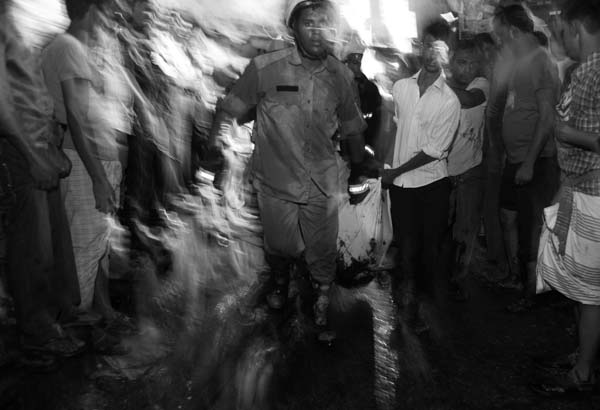
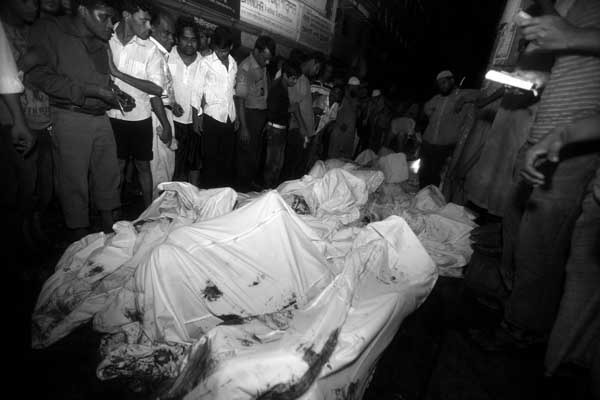
Fire is an ever present death threat for the entire community of Dhaka city. From homes and workplaces to shopping malls and public spaces, a lack of building codes and fire protection have created a situation where residents are living in a continual death trap. And due to lack of training and proper rescue equipment for the fire service authority, fire accidents are responsible for the destruction of assets and homes as well as lives. The widespread lack of equipment and protection means fire deaths affect nearly everyone, from working class to middle class, and even the elites.
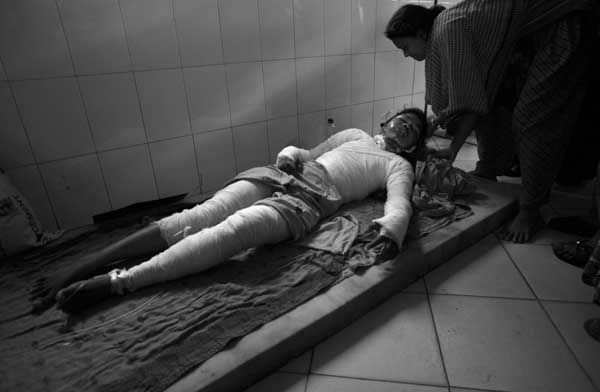
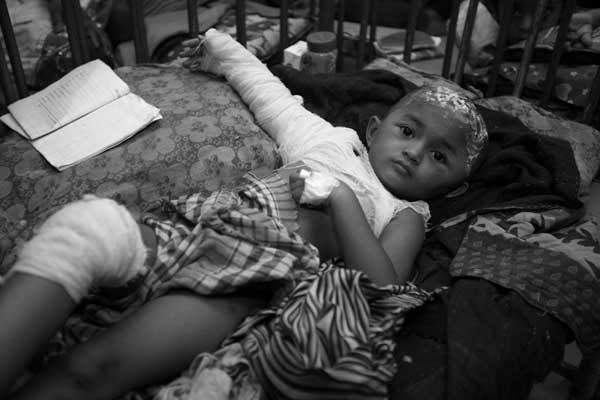
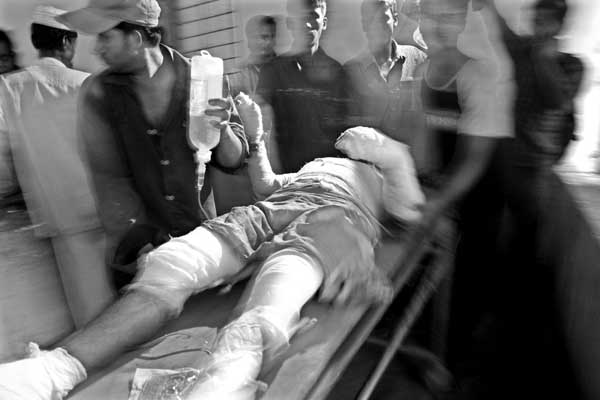
I have been documenting the important issue of fire risks faced by residents of Dhaka for the last couple of years. Through my work, I have seen civilians risking their lives to save others in rescue operations. Firefighters with lack of training and proper rescue equipment are also part of the rescue operation, bringing injured and panicked victims of fire to safety. I believe my photo essay will raise awareness, and hope that it will act as a catalyst for the authorities to take prompt action to save the life and property of an entire community. I hope it will help the policy makers and administrations to consider how Dhaka city has become the ?second worst? livable city in the world. I want to show how reversing the trend of inefficiency and neglect by the authorities can help bring an end to the needless loss of many lives in the peaceful, beautiful city of Dhaka.
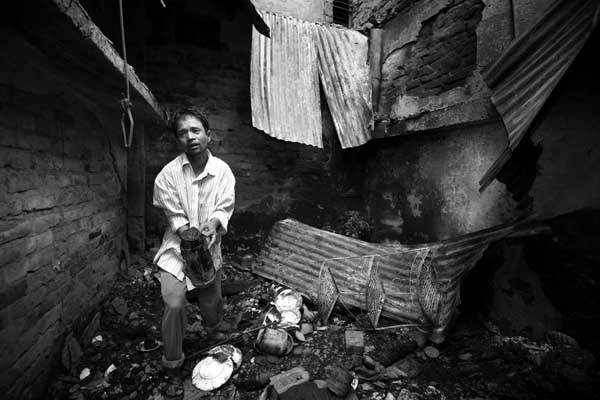
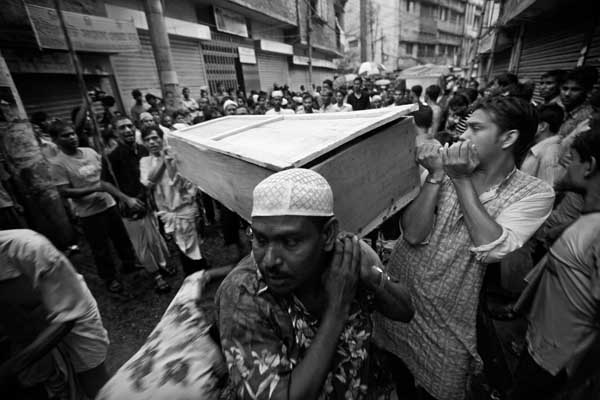
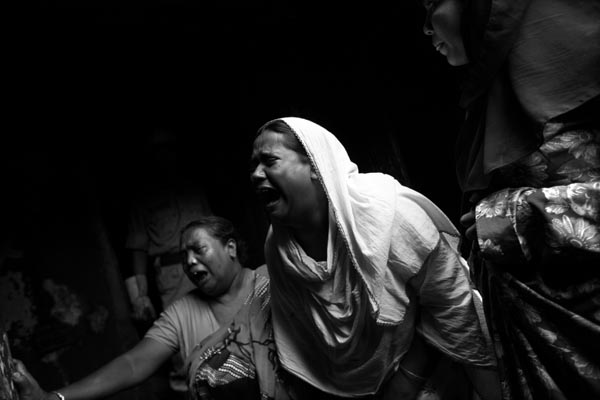
—
Abir Abdullah
Photographer
european pressphoto agency b.v. (epa)
Bangladesh Bureau
Mobile: 8801715105546
More pictures at:
Just Hand Me A Biri
![]()
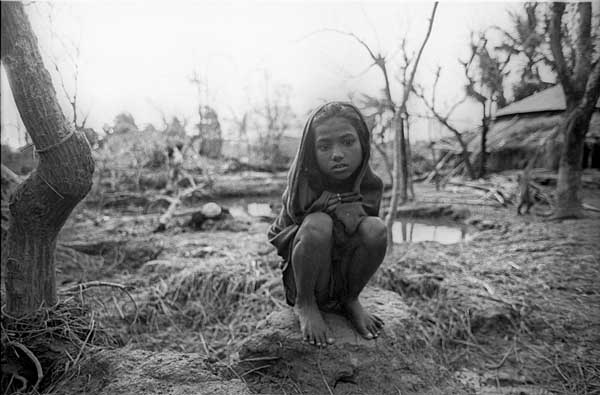
Orphaned girl by the remains of what was her home. Anwara. Bangladesh. 1991. ? Shahidul Alam/Drik/Majority World
“The dark cyclone shelter was packed with people, mostly women and children, some crying, some screaming. It was chaos. And then there was the loud knock. We struggled to open the door against the wind, The whole night sky tried to get in through the small gap we had made. The man pushed his way in as we struggled to lock the door again. He was a strong burly man, but he was shaking. “Give me a biri (hand rolled cigarette)” he said. I got angry. “Can’t you see what is happening here? What state people are in? And you want a biri?” He wasn’t harsh, but his stare was cold. “Agaro jon re puita aisi. Biri de.” (I’ve buried eleven. Just hand me a biri).”
This had been 1991. We had crossed into Hatia, and the ride across the choppy sea had left us all rattled. Slowly people spoke of their experiences on the night of the 29th April 1991, when the sea had become a wave.
This time I was stranded in Kathmandu when I received the news from Rahnuma. She was dreading the worst. The ticker tape on CNN said the storm was 100 kilometres from Dhaka, when I finally went to sleep in the early hours of the morning. This was the time of Internet and mobile phones, but the Net was down and the network was too congested to get calls through. Irfan managed to send a text the next day asking me to charge my mobile. Dhaka had no electricity.
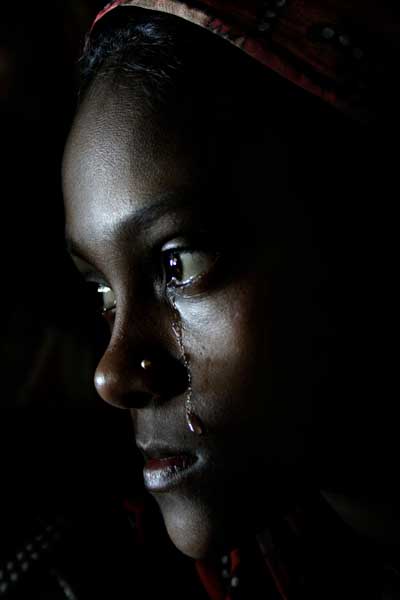
Cyclone SIDR. Dublar Char, Bagerhat, Bangladesh. November 26 2007. ? Asad/DrikNews
Joshim was waiting as usual at the airport. At least there was electricity there. Some of the street lamps were lit. I managed to make it home in the early hours of the morning. Most of Dhaka was then in darkness. We did have electricity in the flat, but it soon went. Ragni and Nunni (two of our many children) were both fast asleep. Ragni went off this morning to an FK meeting, an exchange partnership we are involved in. The Net is up again, at least partially. Nipun is designing the majority world flyer. Life goes on. We don’t yet know the extent of the damage, but the figures are undoubtedly high. We are fine. Many others sadly are not.
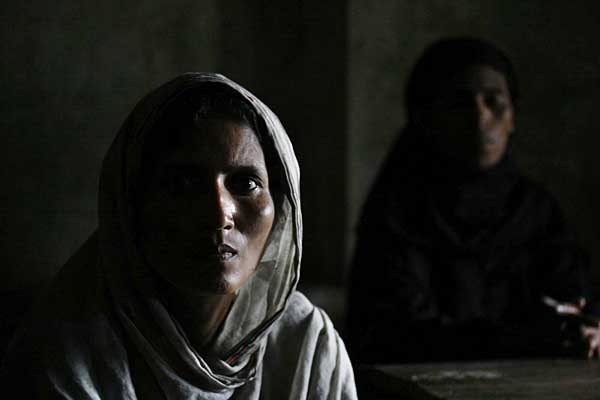
Women in a cyclone shelter centre at Coxbazar, Bangladesh. Cyclone SIDR. November 16 2007. ? Munir uz Zaman/DrikNews
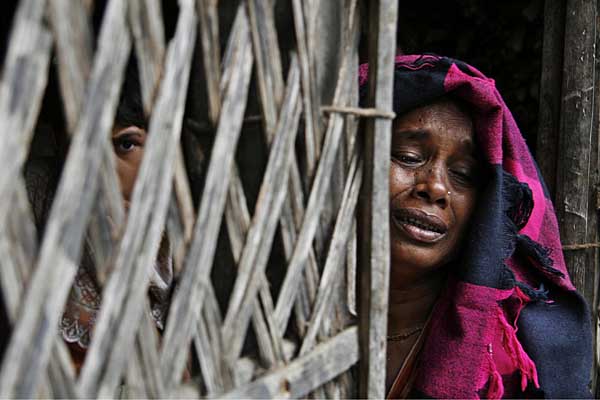
A woman weeps for her lost relatives. Cyclone SIDR. Khulna. Bangladesh. 17th November 2007. ? Tanvir Ahmed/DrikNews
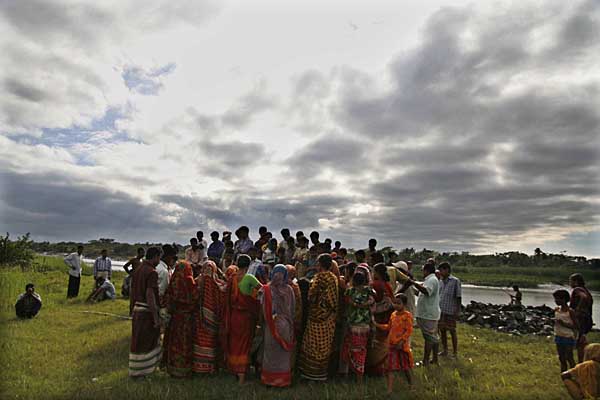
Relatives and neighbours bury their dead by the Rupsha River. Cyclone SIDR. Khulna. Bangladesh. 17th November 2007. ? Tanvir Ahmed/DrikNews
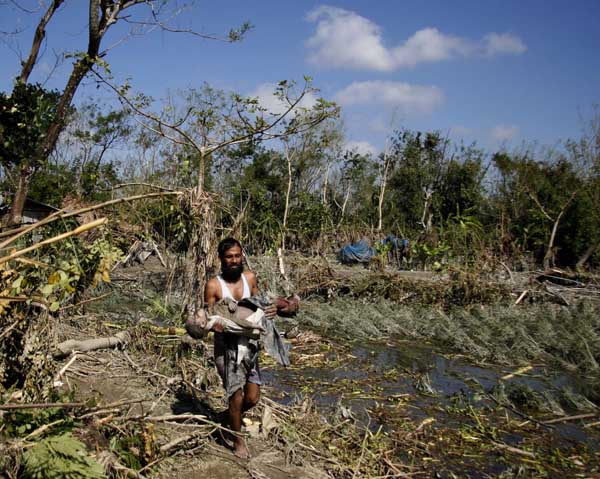
A man carries his grandchild?s dead body from debris of the house. Cyclone SIDR. Shoronkhola, Bagerhat, Bangladesh. November 19 2007. ? Tanvir Ahmed/DrikNews
My bike was at Drik, so I took a rickshaw to the office. The rickshawalla’s name was Shah Alam. Our similar names added to our camaraderie. He was from Bhola. They had lost twelve. “But I have a mobile” he said sheepishly. Almost apologising for this perceived opulence. “At least this way I can talk to my parents.”
Abir and Munir are already out there. Jessica is preparing to leave for Patuakhali. In 1991, I had rushed back from Feni and managed to bluff my way into a military helicopter to do a story with Barbara Crossette for the New York Times. Sending the picture through the old fax transmitter in the T&T office took hours. With most connections down, we had struggled to get the picture through. And then I was out again. It was only when I met James Nachtwey in Chittagong that I found out that my picture had made the front page of the Herald Tribune. Now as I sit behind a computer screen typing text and booking tomorrow’s flight to Sri Lanka, other photographers are headed for the coastline.
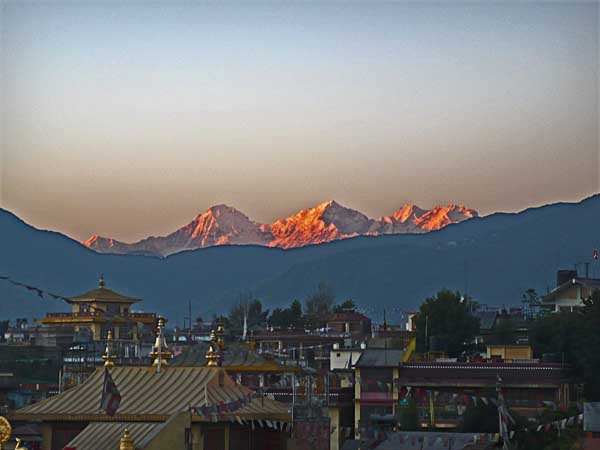
Sunset on the outskirts of Kathmandu. Nepal. 16th November 2007. ? Shahidul Alam/Drik/Majority World
Last night as we waited for yet another hugely delayed GMG flight, Nayantara took Tutul and I to catch the last glimpse of sunlight in the mountains outside Kathmandu. The chanting of the priests, and the gentle bells from the stupa below made Dhaka seem far away. We even stopped to give an interview on CJMC’s new FM station. Back home Bazlu bhai and his team have been pushing for permission for community radio for years. A much needed tool in times of crisis. The airwaves here have been reserved for propaganda. A once outspoken media sings the glory of the military and the untiring efforts of the government. Some with reluctance.
Saving people’s lives seems a far lesser priority.
——
Find link for interview on Radio France Internationale (streaming)
Afsan Chowdhury’s interview on climate change in Bangladesh
or download file: sa-2nd-clip-from-french-radio-on-cyclone.mp3
article-on-natures-fury.pdf (from the Book: Communicating Disasters, by TVEAP and UNDP)
Imaging Famine and other events
![]()
Born Aid 20. The Commission on Africa. Live 8. Make Poverty History. The G8
Summit in Gleneagles. We are witnessing renewed debate about global poverty,
disasters and development, especially in Africa. Coming two decades after
the Ethiopian famine of the mid-1980’s the time is ripe for a
reconsideration of the power and purpose of disaster pictures given the way
the images of the Ethiopian famine spawned the original Band Aid/Live Aid
phenomenon.
http://www.imaging-famine.org/
Imaging Famine is one of several intriguing events I’ll be involved with in
September 2005. The event in New York is not public, so I’ve left out the
details, but I will be there in case anyone wants to meet up.
5th and 6th September: Imaging Famine Conference
The Newsroom. Guardian. London. UK
contact: Dave Clark, Bolton University: dj at djclark.com
http://www.imaging-famine.org/
*8th September: Panel Discussion: Imaging Development*
*Open University Campus, **Milton Keynes**. **UK***
*contact: Helen Yanacopulos, Open University: H.Yanacopulos at open.ac.uk *
*http://www.devstud.org.uk/Conference05/abstracts/PED.htm *
10th September: Symposium, A Critical Evaluation of Photographic
Commissions
Sunderland University. Sunderland. UK
contact: Bas Vroege, Paradox: Ebv at paradox.nl
http://www.theiprn.org/temp/media/pdf/folder.pdf
12th ? 14th September: New York
17th and 19th September: 15th Videobrasil International
Electronic Art Festival
Sesc Pomp?ia, S?o Paulo. Brazil
contact: Luciana Gomide, Video Brasil: *fcfcom at uol.com.br*
www.videobrasil.org.br <http://www.videobrasil.org.br>**
**
22nd September: Launch of Internatioanal Touring Exhibition: Tales From a
Globalising World
Drik Gallery, Dhaka, Bangladesh
contact: Rezaur Rahman, Drik: reza at drik.net
http://www.foto8.com/reviews/V2N3/globalizing.html
24th September: National Geographic’s All Roads Film Festival
Egyptian Theatre: Los Angeles. USA
contact: Alexandra Nicholson, National Geographic: anichols at ngs.org
http://www.nationalgeographic.com/allroads/schedules_la.html
26th September: Presentation: “In Search of the Shade of the Banyan Tree”
UCLA. Los Angeles. USA
contact: Angilee Shah: angshah.asiamedia at gmail.com
29th September: Conference: Free Media
The Norwegian Institute of Journalism
contact: Solberg Oona, MFA: oona.solberg at mfa.no
http://www.ij.no/friemedier.htm
It was Drik’s birthday yesterday! Sweet Sixteen!
Best wishes,
Shahidul
ps: we’ve started a data entry unit and are looking for work. So if you have
any ideas…
